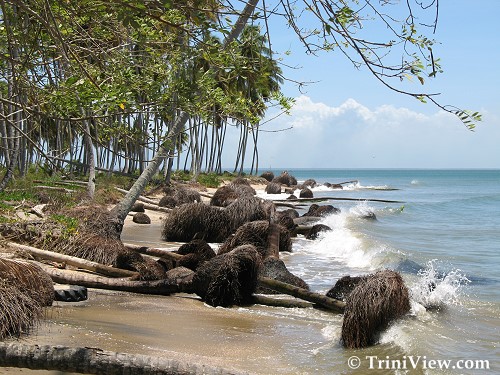 Beach in Constance estate in Icacos
Beach in Constance estate in Icacos
TriniView.com Reporters
Posted: May 10, 2007
Icacos Point is the southwesternmost point in Trinidad and Tobago situated at the tip of the long peninsula that forms St. Patrick County and is only 11 kilometers away from neighboring Venezuela. The village was given its name by the original inhabitants of the area, the Amerindians, who named it after a type of common shrub of the rosaceous or rose family, icaco, that grew profusely there. In fact, the French settlers had later referred to the shrub as "des icaques." The icaco is a velvety fruit that is bluish-red in colour and is commonly called "fat port" in Trinidad and Tobago.
The plum-like fruit was so visible and plentiful that a British surveyor in 1797 had called the area by its French name "Marsh of Icaque". The area was also distinguished, as the name suggested, by swampy, flat land that contained within its interior several lakes, savannahs and lagoons. The area was uninhabited by the time the British had arrived.
Christopher Columbus on his third voyage, had several historically documented adventures off the peninsula. He first sighted the land on 31st July, 1498, and called the island "Trinidad". According to Columbus' own records, the anchors of his ships were only dropped when he reached the cape and had called it "Punta del Arenal" which means "tip of the sandbank."
On the second day, while still onboard the vessel, Columbus and his crew had observed a large canoe with twenty-four Amerindians armed with bows, arrows and wooden shields. In a very clumsy attempt to gain the attention of the canoemen, Columbus had ordered his men to play drums and dance. The Amerindians, in response, had showered arrows onto the ship and later fled.
Columbus, in his private notes, also mentioned the rough waters that run constantly from east to west, fed largely by the Orinoco river from the South American mainland. According to him, "...it appeared impossible to move backward, for the current, and forward, for the shoals." Because of this, and the ship's anchor was snapped after a series of violent waves, he named the bay "Boca de la Sierpe" or "Mouth of the Serpent"/ "Serpent's Mouth" which is also known as the Columbus Channel. He later named the narrow section of land extending into the sea "Punta del Gallo" or "Tip of the Rooster"/ "Point of the Cockerel". Subsequently, the area was referred to as "Los Gallos" or "The Cocks."
Almost a century later in 1595, Sir Walter Raleigh also ventured to the shores of Point Icacos in his quest for "El Dorado" but he never went onto the land.
When British explorers came to Trinidad and visited Icacos in 1797, they saw the environment similar to how their European predecessors had, except for the presence of the proprietor, Monsieur Cap-de-Ville who arrived earlier with the French under the Cedular of Population decree.
By the 1820's, Icacos increasingly became an agricultural area with estates such as Columbia and Constance coming into being. In 1877 the first school in the area was built on Constance estate with forty-nine students in attendance under the tutelage of school-master, Mr. Lazare.
By 1881, census reports show that there were five-hundred and two people in the area but with no public services available except through the nearby Cedros area.
Today, Icacos has largely abandoned its agricultural roots and villagers engage mainly in fishing for their sustenance. Many types of fishing are engaged by the fishermen such as drift-net fishing, "floating" and long-line fishing. However, shrimp-fishing, which is done primarily at night, is one of the most popular forms of fishing. This form of fishing is not without controversy because the shrimp beds lie in the direction of Venezuelan waters and many a fisherman have been arrested and their catch confiscated. Fishing agreements made between Venezuela and Trinidad and Tobago have helped the situation somewhat.
Notes: "Towns and Villages of Trinidad and Tobago" by Michael Anthony
Also Read:
Journey to Icacos
Icacos in pictures:
www.triniview.com/gallery/main.php?g2_itemId=172151
Homepage | Carnival | Special Events | Photo Gallery
|
